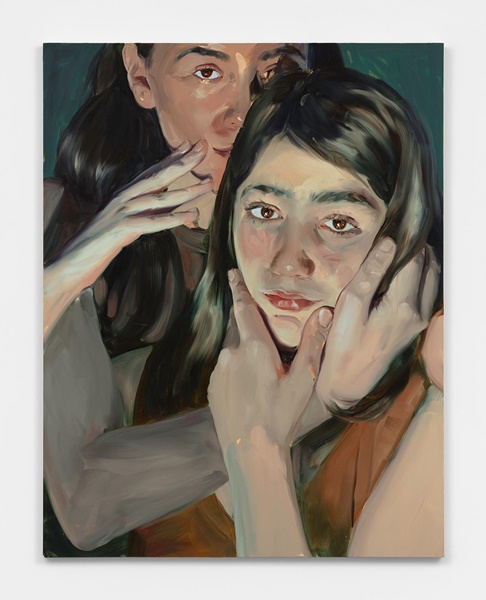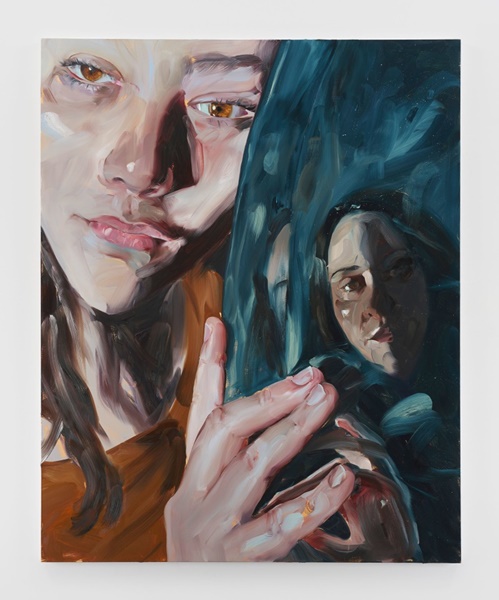KORDANSKY DAVID,LOS ANGELES CA , U.S.A. - Jenna Gribbon : Like Looking in a Mirror - 13 September > October 19, 2024 @davidkordanskygallery
Like Looking in a Mirror
Jenna Gribbon

KORDANSKY DAVID
5130 W. Edgewood Pl. Los Angeles, CA 90019Tel. 323.935.3030 Fax. 323.935.3031 e-mail:
OVERVIEW :
David Kordansky Gallery is one of the most dynamic venues for contemporary art, and is internationally regarded as a leading gallery of its generation. Established in 2003 as part of a burgeoning artistic community in Los Angeles’s Chinatown neighborhood, the gallery began as a cutting-edge incubator for emerging talent. It quickly grew into a widely respected voice in the international conversation surrounding new and recent art, and moved to its second home, in Culver City, in 2008.
gallery's Multiple Locations :New York NY, Los Angeles CA
13 September > October 19, 2024




Jenna Gribbon, Entwined, 2024, oil on linen, 92 x 72 x 1 3/4 inches (233.7 x 182.9 x 4.4 cm). Photo: Christopher Stach


Jenna Gribbon A Reflection Held, 2024 oil on linen 80 x 64 x 1 3/8 inches (203.2 x 162.6 x 3.5 cm)
ABOUT EXHIBITION : Like Looking in a Mirror
Over the past two decades, Gribbon has maintained a consistent engagement with portraiture and the ways in which—through the incorporation of props, and the positioning and gaze of her subjects—she can alter the viewer’s experience of looking. In a departure from recent work, which predominantly featured her wife Mackenzie Scott, the artist returns to a familiar subject—her son—in an effort to explore the replication of traits, appearance, and mannerisms between parent and child that create a sameness which extends beyond the physical into the experiential.
The artist’s past work has depicted sweeping scenes—created with props such as clamp lights, projectors, mirrors, and backdrops—that initially appear intimate, but reveal themselves to be constructed upon closer looking. However, these paintings offer a counterpoint by utilizing the large canvases to portray tighter crops of figures’ heads and shoulders, shifting the focus away from narrative towards more psychological, close-up readings. The paintings become examinations of the tensions and anxieties that arise when an artist confronts an image that closely mirrors their own. The works on view also offer a rare glimpse into the dynamics between a parent and child, where the child lives as a double or a projection of a parent, mirroring aspects of their internal self and therefore, heightening the sense of confusion around selfhood and prompting questions about perception.
Reflective surfaces and mirrors play a central role in this body of work conceptually, as a device that can aid in the act of seeing and representing doubles or doppelgangers. While doubles and doppelgangers have existed throughout time and are often perceived as a bad omen or threatening force, which the artist alludes to through the use of predominantly darker tones, Gribbon’s impressionistic brushstrokes and empathetic and collaborative approach to figural painting reframe the traditionally disturbing or eerie connotation of doubles to create tender portraits imbued with care. In one example, Gribbon and her son are seen with their arms entangled around one another as their eyes look back at the viewer. The artist’s own presence in the painting, along with her stern gaze, reinforces her role as the child’s protector, as her arm lightly shields him from behind. This is one of several instances in which Gribbon distinguishes herself by her position as a secondary yet omnipresent figure, simultaneously watching after her son and after the viewers looking at the two of them.
The artist explores ideas of the uncanny and projection—both literally and metaphorically—by utilizing projectors as a tool to further distort an image and blur the lines between her face and her son’s. In one work, we see a close-up of her son with an image of Gribbon projected onto—and partially obscuring—his cheek. The eyes, nose, and lips appear in duplicate. Though this could be a result of image manipulation, it is, in fact, the result of the physical layering of Gribbon’s image atop her son’s. The projected image of Gribbon’s face originated from a photo taken by her which appears in several works on view, further emphasizing the artist’s commitment to collaboration and a multifaceted engagement with her subjects.
ABOUT ARTISTS : Jenna Gribbon
Jenna Gribbon’s (b. 1978, Knoxville, Tennessee) oil paintings constitute an important new entry in the long lineage of figurative art, extending its narrative possibilities to explore the act of looking. Her vivid portraits, frequently nudes or partial nudes, depict those closest to her, and sometimes the artist herself, in candid poses, during uncanny moments. Replete with saturated colors—and spot lit in awkward, uncomfortable, or humorous positions—the protagonists are often seen looking directly at the artist, blurring the line between observer and the observed. By including her own image in her paintings, whether it’s her legs brushed up against her partner’s or her dramatic shadow lurking in the foreground, Gribbon becomes both actor and director in an unfolding storyline that is equal parts comedic, tender, fantastical, and dark. She uses scale to decipher between true-to-life and constructed scenes. In her larger paintings, Gribbon employs strategically placed props—mirrors, blindfolds, clamp lights, colored gels, green screens—to explore different types of mediation that affect image consumption and investigate the power dynamics between subject, artist, and viewer. Her recent work most prominently features her partner, Mackenzie Scott, whose recurrence both personalizes and simultaneously establishes her as a kind of avatar; shifting the focus of the painting away from the figure and toward the way the figure is framed. Gribbon’s paintings often begin as a photo taken on her phone, forging a fluid relationship between photography and painting, the real and the surreal, and between the ephemerality of phone photography and the enduring quality of oil paint. By painting otherwise fleeting scenes, the artist adds texture, depth, and a sense of permanency to these temporal images, highlighting themes of pleasure, joy, and expanding the lexicon of queer iconography.
Jenna Gribbon was the subject of a solo exhibition at Collezione Maramotti, Reggio Emilia, Italy (2022–2023). Recent group exhibitions include Day for Night: New American Realism, Palazzo Barberini, organized by the Aïshti Foundation, Rome (2024); Living Histories: Queer Views and Old Masters, The Frick Collection, New York (2022); and I will wear you in my heart of heart, FLAG Art Foundation, New York (2021); and Paint, also known as Blood: Women, Affect and Desire in Contemporary Painting, Warsaw Museum of Modern Art, Poland (2019). Her work is in the permanent collections of institutions including Kunstmuseum The Hague, the Netherlands; Dallas Museum of Art; Marjorie Barrick Museum of Art, Las Vegas, Nevada; New Orleans Museum of Art, Louisiana; Kurpfälzisches Museum, Heidelberg, Germany; Rubell Museum, Miami; and FLAG Art Foundation, New York. Gribbon lives and works in New York.
 Jenna Gribbon
Jenna Gribbon 
ABOUT EXHIBITION : Like Looking in a Mirror
Over the past two decades, Gribbon has maintained a consistent engagement with portraiture and the ways in which—through the incorporation of props, and the positioning and gaze of her subjects—she can alter the viewer’s experience of looking. In a departure from recent work, which predominantly featured her wife Mackenzie Scott, the artist returns to a familiar subject—her son—in an effort to explore the replication of traits, appearance, and mannerisms between parent and child that create a sameness which extends beyond the physical into the experiential.
The artist’s past work has depicted sweeping scenes—created with props such as clamp lights, projectors, mirrors, and backdrops—that initially appear intimate, but reveal themselves to be constructed upon closer looking. However, these paintings offer a counterpoint by utilizing the large canvases to portray tighter crops of figures’ heads and shoulders, shifting the focus away from narrative towards more psychological, close-up readings. The paintings become examinations of the tensions and anxieties that arise when an artist confronts an image that closely mirrors their own. The works on view also offer a rare glimpse into the dynamics between a parent and child, where the child lives as a double or a projection of a parent, mirroring aspects of their internal self and therefore, heightening the sense of confusion around selfhood and prompting questions about perception.
Reflective surfaces and mirrors play a central role in this body of work conceptually, as a device that can aid in the act of seeing and representing doubles or doppelgangers. While doubles and doppelgangers have existed throughout time and are often perceived as a bad omen or threatening force, which the artist alludes to through the use of predominantly darker tones, Gribbon’s impressionistic brushstrokes and empathetic and collaborative approach to figural painting reframe the traditionally disturbing or eerie connotation of doubles to create tender portraits imbued with care. In one example, Gribbon and her son are seen with their arms entangled around one another as their eyes look back at the viewer. The artist’s own presence in the painting, along with her stern gaze, reinforces her role as the child’s protector, as her arm lightly shields him from behind. This is one of several instances in which Gribbon distinguishes herself by her position as a secondary yet omnipresent figure, simultaneously watching after her son and after the viewers looking at the two of them.
The artist explores ideas of the uncanny and projection—both literally and metaphorically—by utilizing projectors as a tool to further distort an image and blur the lines between her face and her son’s. In one work, we see a close-up of her son with an image of Gribbon projected onto—and partially obscuring—his cheek. The eyes, nose, and lips appear in duplicate. Though this could be a result of image manipulation, it is, in fact, the result of the physical layering of Gribbon’s image atop her son’s. The projected image of Gribbon’s face originated from a photo taken by her which appears in several works on view, further emphasizing the artist’s commitment to collaboration and a multifaceted engagement with her subjects.
ABOUT ARTISTS : Jenna Gribbon
Jenna Gribbon’s (b. 1978, Knoxville, Tennessee) oil paintings constitute an important new entry in the long lineage of figurative art, extending its narrative possibilities to explore the act of looking. Her vivid portraits, frequently nudes or partial nudes, depict those closest to her, and sometimes the artist herself, in candid poses, during uncanny moments. Replete with saturated colors—and spot lit in awkward, uncomfortable, or humorous positions—the protagonists are often seen looking directly at the artist, blurring the line between observer and the observed. By including her own image in her paintings, whether it’s her legs brushed up against her partner’s or her dramatic shadow lurking in the foreground, Gribbon becomes both actor and director in an unfolding storyline that is equal parts comedic, tender, fantastical, and dark. She uses scale to decipher between true-to-life and constructed scenes. In her larger paintings, Gribbon employs strategically placed props—mirrors, blindfolds, clamp lights, colored gels, green screens—to explore different types of mediation that affect image consumption and investigate the power dynamics between subject, artist, and viewer. Her recent work most prominently features her partner, Mackenzie Scott, whose recurrence both personalizes and simultaneously establishes her as a kind of avatar; shifting the focus of the painting away from the figure and toward the way the figure is framed. Gribbon’s paintings often begin as a photo taken on her phone, forging a fluid relationship between photography and painting, the real and the surreal, and between the ephemerality of phone photography and the enduring quality of oil paint. By painting otherwise fleeting scenes, the artist adds texture, depth, and a sense of permanency to these temporal images, highlighting themes of pleasure, joy, and expanding the lexicon of queer iconography.
Jenna Gribbon was the subject of a solo exhibition at Collezione Maramotti, Reggio Emilia, Italy (2022–2023). Recent group exhibitions include Day for Night: New American Realism, Palazzo Barberini, organized by the Aïshti Foundation, Rome (2024); Living Histories: Queer Views and Old Masters, The Frick Collection, New York (2022); and I will wear you in my heart of heart, FLAG Art Foundation, New York (2021); and Paint, also known as Blood: Women, Affect and Desire in Contemporary Painting, Warsaw Museum of Modern Art, Poland (2019). Her work is in the permanent collections of institutions including Kunstmuseum The Hague, the Netherlands; Dallas Museum of Art; Marjorie Barrick Museum of Art, Las Vegas, Nevada; New Orleans Museum of Art, Louisiana; Kurpfälzisches Museum, Heidelberg, Germany; Rubell Museum, Miami; and FLAG Art Foundation, New York. Gribbon lives and works in New York.
 Jenna Gribbon
Jenna Gribbon web : not found or not exist mail : not available
Gallery Opening Hours : Tuesday-Saturday 10am–6pm
Opening reception :Friday, September 13, 6 – 8 PM PT
mpefm U.S.A. art press release
QR of this press release
in your smartphone, tablet








